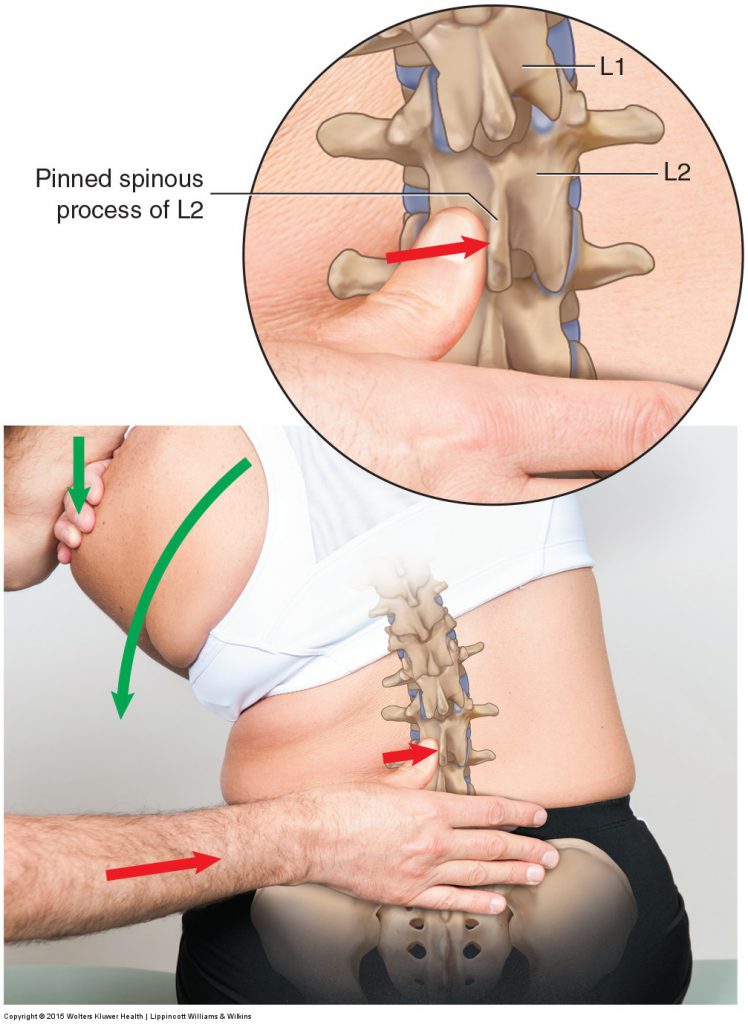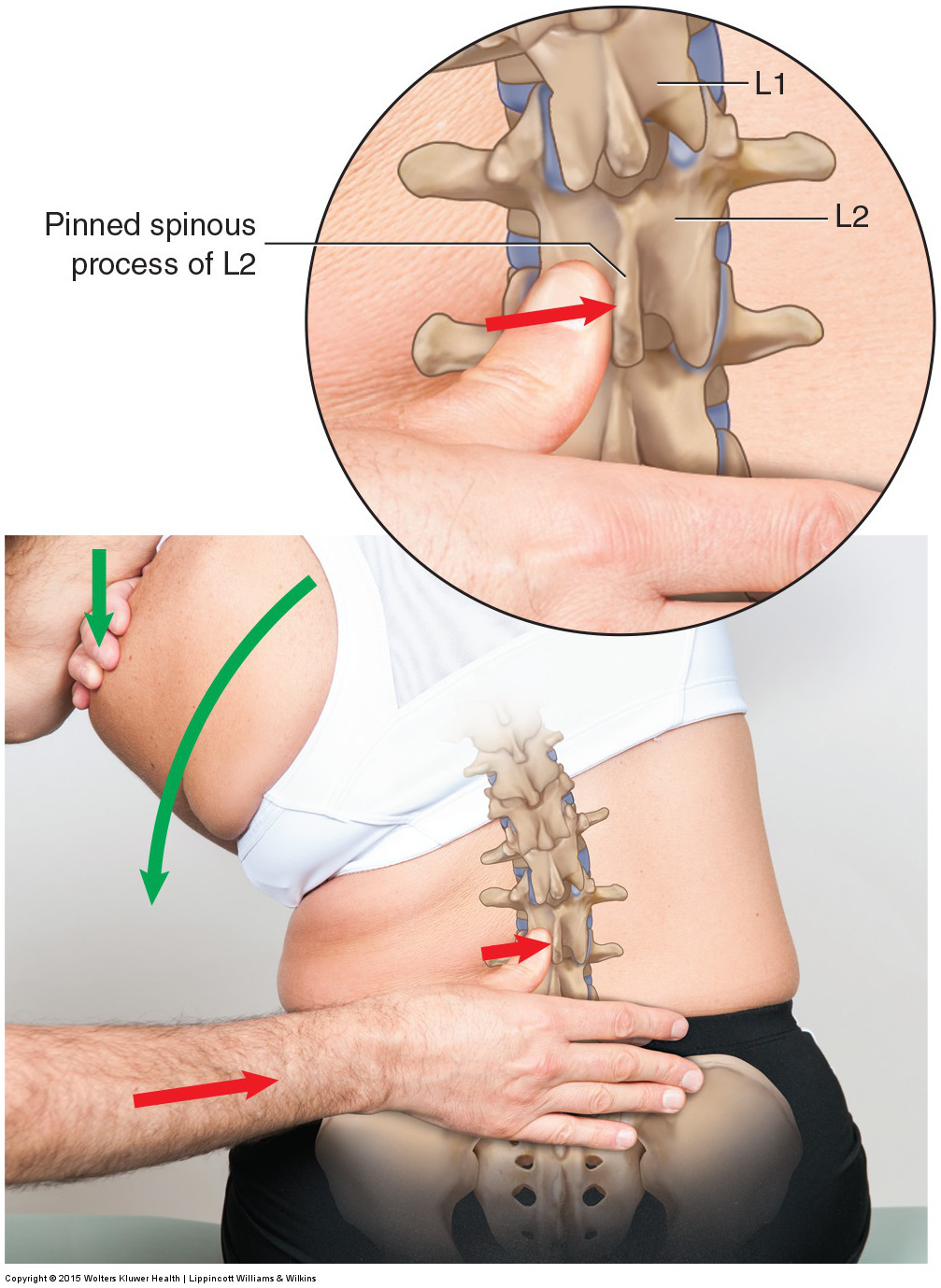This blog post article is part of a series of articles on assessment of the low back and pelvis. Scroll to the end of this article to see the others in this series.
Motion Palpation

Figure 5. Left lateral flexion joint play assessment of the lumbar spine. The pelvis and lower lumbar spine are stabilized by body weight and the therapist’s thumb while the rest of the body, and therefore the vertebra immediately superior, is moved into left lateral flexion relative to it. Motion palpation allows for specific assessment of the soft tissues of only that segmental level of the spine. In this figure, the L1-L2 joint is being assessed. Permission Joseph E. Muscolino DC. Manual Therapy for the Low Back and Pelvis – A Clinical Orthopedic Approach (2015).
Joint motion palpation assessment, also known as joint play assessment, is essentially a focused and specific form of passive ROM assessment. Instead of moving or stretching the entire low back or pelvis in a certain direction, the motion is directed at one segmental joint level. This is important because it helps narrow down the area where the problem exists. For example, if the therapist passively moves the client’s entire low back into right lateral flexion and the motion is decreased, the only information that procedure reveals is that decreased motion, or hypomobility, exists in that direction. It does not reveal whether every joint of the lumbar spine is hypomobile in that direction, or whether the hypomobility is present at just one or a few of the segmental joint levels. Joint play assessment makes it possible to discern this.
In fact, it is entirely possible for there to be a hypomobile joint level within the lumbar spine in right lateral flexion passive ROM while the entire lumbar spine has a normal degree of motion. If one segmental level is hypomobile and produces insufficient movement, another adjacent joint level might become hypermobile to compensate. This makes it possible for the gross ROM of the entire lumbar spine to be normal while lumbar hypomobilities and hypermobilities are present. Therefore, the only way to determine the health of a specific segmental joint level is to employ motion palpation assessment.
Assessment is Treatment
Motion palpation assessment is essentially the same as joint mobilization (arthrofascial stretching) treatment technique. The therapist pins (fixes/stabilizes) one lumbar vertebra, usually by positioning the client such that body weight creates the stabilization force or by pinning the vertebra with a thumb pad, while moving the vertebra immediately above (along with the rest of the spine above that point) relative to the lower vertebra (Fig. 5). This procedure isolates the motion to the segmental joint level that is located between these two vertebrae, thereby allowing the therapist to assess specifically that joint level’s end-feel motion. By performing joint play assessment at each level of the low back, it is possible to assess specific hypomobilities and hypermobilities throughout the lumbar spine and target treatment to those levels. This technique can also be used to assess the segmental motion of one SIJ of the pelvis relative to the other. This is accomplished in a similar manner: one pelvic bone is stabilized and the other pelvic bone or sacrum is moved relative to it.
Caution
Before employing motion palpation assessment technique, be certain it is within the scope of practice of your profession. If there is any doubt about the ethical or legal application of joint motion palpation within your profession, please check with your local, state, or provincial licensing or certifying body, and/or your professional organization.
Motion palpation assessment, like joint mobilization technique, is performed by bringing the client’s joint to the end of its passive ROM and then gently applying a small, even, steady force for less than a second that further stretches the joint in the desired direction. It cannot be emphasized too strongly that the force applied to assess joint play must be gentle, even, steady, and for less than 1 second. Motion palpation assessment and joint mobilization technique should never involve any type of fast or sudden thrust. A fast thrust within the realm of joint play is defined as a chiropractic or osteopathic adjustment and cannot be legally performed by most manual therapists.
(Click here for a blog post article on motion palpation of the cervical spine.)
(Click here for a blog post article on the motions of the lumbar spine.)
(Click here for a blog post article on motions of the joints of the pelvis / sacroiliac joints.)
This blog post article is the 7th in a series of 18 blog posts on the subject of assessment of the low back and pelvis.
The blog post articles in this series are:
- Introduction to Assessment of the Low Back and Pelvis
- Health History
- Introduction to Physical Assessment Examination of the Low Back and Pelvis
- Postural Assessment of the Low Back and Pelvis
- Range of Motion and Manual Resistance Assessment of the Low Back and Pelvis
- Muscle and Bone Palpation of the Low Back and Pelvis
- Joint Motion Palpation Assessment
- Overview of Special Orthopedic Assessment Tests of the Low Back and Pelvis
- Straight Leg Raise Tests for Space-Occupying Lesions
- Cough Test and Valsalva Maneuver
- Slump Test
- Piriformis Stretch Test
- Straight Leg Raise and Manual Resistance Tests for Strains and Sprains
- Nachlas and Yeoman’s Tests
- Sacroiliac Joint Medley of Tests
- Treatment Strategy for the Low Back and Pelvis
- Self-Care Advice for the Client with a Low Back / Sacro-Iliac Joint Condition
- Brief Review of Assessment and Treatment of Conditions of the Low Back and Pelvis


